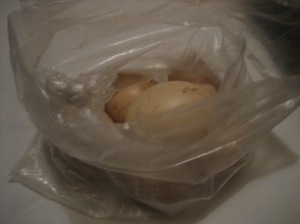I finally got around to making my own dish soap. One of the first diy projects I made last year was liquid hand soap and I have really liked it. So now I am finally ready to share the natural soap experience with my dishes.
I found a homemade dish soap recipe on Pinterest as always. It is super easy and cheap to make and takes no time. Another thing I liked about this recipe is that it only makes one portion of dish soap instead of a gallon, allowing me to test it out before I make enough to last me the year.
Ingredients
1/4 cup soap flakes
2 cups distilled water
1 Tbs distilled white vinegar
1 Tbs glycerin
Directions
Next pour the distilled water into a pot and then add the grated soap flakes.
Then heat the soap flakes in the water over medium heat stirring and making sure it doesn't boil.
Then heat the soap flakes in the water over medium heat stirring and making sure it doesn't boil.
Once the soap flakes have dissolved in the water, add the glycerin.
Pour the soap mixture into a bowl and let it cool off.
When it is a little cooler add the vinegar (do not add vinegar if you used castile soap - see recipe below).
Let it cool completely and then add your soap to your dish soap bottle and you are ready to use it!
Modified recipe if using castile soap
As I mentioned in my previous post about making cleaners with castile soap, castile soap and vinegar cancel each other out.
I already had a castile bar of soap with citrus which I thought would smell yummy in a dish soap and citrus is a great degreaser so I decided to make a batch of dish soap with it. Knowing I couldn't use distilled white vinegar with the soap flakes, I adjusted the recipe. Instead of vinegar I added 10 drops of tea tree oil which is a natural antibacterial and antifungal essential oil. Otherwise the recipe is the same.
The difference between the two dish soaps ....
The dish soap using the castile bar of soap smelled very yummy naturally. It was however a lot thicker than the other dish soap. One of the reasons may be that I noticed the vinegar made the first soap a little thinner after I added it. The castile dish soap consistency was more snotty:) which is a common thing for homemade liquid soaps. The first dish soap is more runny and thinner than store bought dish soap. Also, some people complain about castile soap leaving a film on their dishes. All in all, both of the dish soaps seemed to clean the dishes which is the idea behind dish soap:)
The difference between homemade dish soap and store bought dish soap...
As I mentioned above, the consistency of homemade dish soap is different than store bought dish soap which may be hard to get used to.
Another difference is that it doesn't really bubble.
Consistency and bubbles however don't indicate whether something is clean.
It is also a lot cheaper to make your own dish soap than buying natural dish soap.
So whether or not you use natural homemade dish soap is a matter of preference ...
It is also a lot cheaper to make your own dish soap than buying natural dish soap.
So whether or not you use natural homemade dish soap is a matter of preference ...

















































